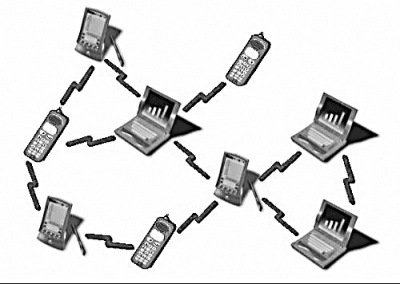Before talking about the protagonist, give a background. In 1968, the United States established the ALOHA network, which requires fixed base stations. Each node in the network must be directly connected to all other nodes to communicate with each other. It is a single-hop network; in 1973, the United States developed and established PR Network, there is a real multi-hop network, the so-called "multi-hop", that is, each node in the network does not need to be directly connected, but can be relayed, in two nodes that are far away and cannot communicate directly Transfer information between. Once the PR network was built, it was widely used in the military field. On the basis of these two networks, the International Organization for Standardization, IEEE, when developing the 802.11 standard, proposed to rename the PR network to the Ad Hoc network, which is today's protagonist-the mobile self-organizing network.
A mobile ad hoc network is a combination of mobile communication and computer network. It is a type of mobile computer network. User terminals can move freely within the network to maintain communication. On the one hand, the network information exchange uses packet switching in the computer network instead of circuit switching; on the other hand, the user terminal is a portable terminal that can be moved, such as a notebook, PDA, etc., and the user can be in a mobile or stationary state at any time. Each user terminal in the mobile ad hoc network has both router and host functions. As a host, the terminal can run various user-oriented applications; as a router, the terminal needs to run the corresponding routing protocol. This distributed control and decentralized network structure can maintain the remaining communication capacity after some communication networks are destroyed, and it has strong robustness and invulnerability.

As a distributed network, mobile ad hoc networks do not have a fixed infrastructure, and can provide mutual communication between terminals without using or facilitating the use of existing network infrastructure. Due to the limited transmission power and wireless coverage of the terminal, if the two distant terminals want to communicate, they must use other nodes to forward packets, so that a wireless multi-hop network is formed between the nodes.
The mobile terminals in the network have routing and packet forwarding functions, and can form any network topology through wireless connection. The mobile ad hoc network can work independently as a separate network, or it can connect to existing networks in the form of terminal subnets, such as mobile networks, wired networks, the Internet, and RFID technology. The process of convergence will effectively expand the functions and effective coverage of these networks, and has obvious application value, but it also brings new topics, that is, the need to study the seamless switching technology between mobile ad hoc networks and these broadband networks, especially The connection between mobile networks, so as to achieve direct communication between mobile terminals, multi-hop communication, system compatibility, seamless switching and roaming.
The biggest feature of mobile self-organizing network is self-discovery, automatic configuration, self-organization and self-healing. Network nodes can adapt to the dynamic changes of the network, quickly detect the presence of other nodes and detect the set of capabilities of other nodes. Network nodes coordinate each other's behavior through distributed algorithms without manual intervention and any other preset network facilities. Quickly expand anywhere and network automatically at any time.
Self-organizing networks are generally used in environments with limited wireless transmission bandwidth, mobile terminals with energy-saving requirements, low security requirements, and unidirectional wireless channels. In the current situation of increasing energy consumption in mobile communications, many concepts of self-organizing networks have broad application prospects.
At present, mobile ad hoc networks are a hotspot in the field of academic research. Research papers on its MAC layer protocols, routing protocols, security mechanisms, and QoS mechanisms are emerging in an endless stream. The technology is gradually being improved, and the industrialization process is also in order. Of course, there are many issues that need to be solved, such as a reasonable business model and how to build a benign industrial chain that is driven by demand and that operators and manufacturers actively participate.
Smart Ceiling Light,Cheap Ceiling Lights,Ultrathin Ceiling Lamp,Ultra Thin Led Lights
Changxing Fanya Lighting Co.,Ltd , https://www.fyledlights.com